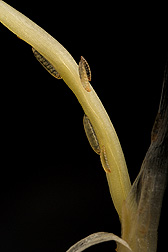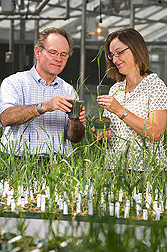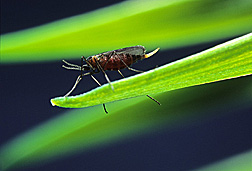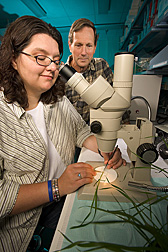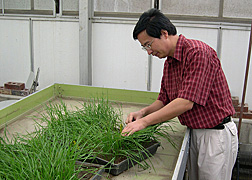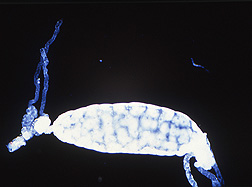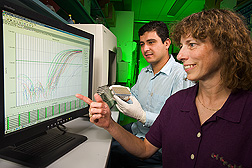Once Again . . . Waiting in the Wings . . . HESSIAN FLIES!
|
|
ARS has done such a good job of combating the Hessian fly pest of wheat that many people think the problem is history.
Not so, says Brandon J. Schemerhorn, an ARS entomologist in the Crop Production and Pest Control Research Unit at West Lafayette, Indiana. That’s where historic Hessian fly research was begun in the 1920s.
“We have been successful so far, but we also have to keep researching to stay one step ahead of it,” says Schemerhorn. “We have a lot more tools to fight it today, but so does the fly.”
Every year, wheat farmers across the nation send samples of fly-infested wheat to Schemerhorn and her colleagues—usually in late December, when winter wheat is maturing. In 2005, they received about a dozen samples.
In the Southeast, where infestations are more common, there have been unusually severe outbreaks in recent years. In 2006, the West Lafayette area saw its first Hessian fly infestation in more than a decade. Over the last 2 years, the flies showed up in Missouri for the first time ever, indicating their westward expansion.
“By 2000, they’d adapted enough to overcome the four primary wheat resistance genes,” says Schemerhorn. “It took them just 14 years to overcome that defense. Now we use those four genes as a standard to judge the virulence of Hessian flies as they grow ever stronger.”
Where have they been hiding between appearances? Schemerhorn says there is evidence that tall fescue grass is providing safe harbor for Hessian flies until they can find wheat fields.
Schemerhorn’s collaborators include fellow ARS entomologist Rich Shukle; ARS molecular biologist Christie Williams; entomologist Jeff Stuart and wheat breeder Herb Ohm, both of Purdue University; and ARS entomologist Ming-Shun Chen at the ARS Grain Marketing and Production Research Center (GMPRC) in Manhattan, Kansas. The Manhattan group mainly covers U.S. areas growing hard wheat, while the West Lafayette unit focuses mostly on soft red winter wheat. Both labs send out Hessian fly-resistant wheat germplasm to wheat breeders.
Monitoring Genetic “Conversations”
Williams, Shukle, and colleagues have assembled a custom biochip, or microarray, containing 2,000 genes expressed by the Hessian fly larva and 1,000 genes expressed by the wheat plant when the insect first pokes at it. These 1,000 genes are involved in wheat’s resistance to Hessian flies. The West Lafayette researchers also have a commercial biochip to assay the expression of 60,000 wheat genes.
“Our biochip gives us a genetic record of the fly and wheat ‘talking’ to each other,” says Williams. She and colleagues have found that the Hessian fly-wheat interaction is very unusual for pest-host relationships. Their modern genetics work has proven what was thought for decades: The fly doesn’t chew on wheat leaves. Instead it injects something into the plant that causes certain wheat genes to turn on and others to turn off.
|
|
Stuart focuses on virulence genes in Hessian fly larvae that trigger a wheat plant’s resistance mechanisms when recognized. If the fly larvae win, the plant turns on a gene—not found in any other plant—that makes its leaves release a liquid the larvae sip on.
“It’s bizarre,” says Williams. “The plant has a gene for its own destruction.”
Death by Saliva
|
|
Hessian flies don’t just suck the liquid life out of wheat plants for their own nourishment. They also inject toxic substances that appear to create a more hospitable feeding environment for them and hasten their access to certain nutrients. It’s an awfully cunning approach for a simple, gnat-sized fly. But considering that this insect has had thousands of years to perfect its assault on wheat, it’s no surprise it’s been so tough to swat.
Fortunately, that’s about to change. Thanks to new genomics technology in the hands of ARS researchers at West Lafayette working with GMPRC colleagues, the fly’s tactics are starting to be revealed genetically.
At the center of the researchers’ study in Kansas—led by Chen—is the insect’s most finely tuned weapon: its saliva. The fly’s salivary glands, acting like tiny poison factories, churn out noxious compounds that cripple wheat plants.
After dissecting thousands of Hessian fly salivary glands and analyzing their DNA, Chen and his team found there’s a lot riding on these salivary defenses. “We’ve identified 97 ‘superfamilies’ of genes that encode secreted salivary gland proteins,” says Chen. Each contains several families with about 10 members, or closely related genes. So far, the Kansas researchers have uncovered roughly 2,000 Hessian fly genes with some role in producing salivary proteins.
With so many genes to sift through and analyze, the researchers’ best bet for pinpointing the most central gene players is the microarray technology. With the help of this powerful tool, they’ll be able to scrutinize all the fly’s salivary genes at once.
Exploring Markered Territory
Schemerhorn says that researchers have only recently acquired enough genetic markers on the fly’s genome to start searching for fly genes that correlate to the resistance genes in wheat plants. It is assumed that for every resistance gene there’s a fly gene that overcomes it.
|
|
The West Lafayette researchers have 52,000 microsatellite markers for Hessian fly genes, with enough duplication and overlap to more than cover the entire Hessian fly genome. Schemerhorn and colleagues are working toward sequencing the entire genome. Tools like this allow a gene-for-gene approach that matches the fly’s strategy of attack.
Schemerhorn is also doing something never done before: She’s sampling all Hessian fly populations across the United States to determine the extent of their genetic variability. The more variable it is, the less likely that the limited number of genes in resistant wheat plants—like the standard complex of four resistance genes currently relied on—will work.
Speeding Breeding
It’s not just fly genes that have captivated ARS researchers. They are also banking on the promise of exceptional wheat lines for fending off Hessian flies.
For example, the GMPRC greenhouses—where more than 5,000 lines of wheat are screened each year—are sprouting with possibility. Particularly exciting is a group of plants from the International Center for Agricultural Research in the Dry Areas, in Aleppo, Syria. In a mutually beneficial exchange, ARS scientists swapped wheat plant material with Syrian researchers and found some samples resistant to Hessian flies in the United States.
In addition to uncovering new resistance in wheat, GMPRC researchers are trying to find out exactly where the genes for that resistance are located. Of the 33 such genes described in the scientific literature, Chen’s group has mapped several of the most effective ones. Many are clustered in and around the same chromosomes. For example, Chen’s group has located 15 Hessian fly resistance genes on wheat chromosome 1A. “This means these genes may have come from the same ancestral gene in grass,” says Chen. Williams and colleagues discovered and mapped the two newest resistance genes, H31 and H32.
Knowledge of gene markers and locations enables breeders to conduct marker-assisted selection. “Using traditional methods, it takes about 6 to 10 years to develop a new wheat cultivar,” says Chen. “With this technology, we can reduce that time. It also makes it much easier to combine, or pyramid, several different Hessian fly resistance genes into one cultivar.” That’s important, given the Hessian fly’s troublingly nimble and adaptive nature.
How Wheat Fights Back
Using microarray technology, Chen’s group recently discovered that wheat’s resistance genes jump-start activities in other genes that perform protective duties. Some barricade plant cells and tissues to deny the larvae food. Others fortify plant cell walls so they can’t easily be penetrated by the fly’s specialized mouthparts.
Williams found three genes turned on by plants in response to Hessian fly bites. They code for putting a protein called “lectin” into the oozed liquid, which causes the fly to get ulcers, lose its appetite, and starve to death.
“This slow killing of the pest is unusual for plants,” says Williams. “They usually emit powerful toxins that will kill the pests rapidly.”
Says Shukle, “We’ll continue to try to stay one step ahead of the Hessian fly and use any down time to gain as complete an understanding of it as possible.”—By Don Comis and Erin K. Peabody, Agricultural Research Service Information Staff.
This research is part of Plant Genetic Resources, Genomics, and Genetic Improvement (#301) and Crop Protection and Quarantine (#304), two ARS National Programs available on the World Wide Web at www.nps.ars.usda.gov.
Brandon J. Schemerhorn, Rich Shukle, and Christie E. Williams are in the USDA-ARS Crop Production and Pest Control Research Unit, 901 W. State St., West Lafayette, IN 47907-2077; phone (765) 494-7494 [Schemerhorn], (765) 494-6351 [Shukle], and (765) 494-6763 [Williams], fax (765) 494-5105.
Ming-Shun Chen is with the USDA-ARS Grain Marketing and Production Research Center, 20 Waters Hall, Kansas State University, Manhattan, KS 66506; phone (785) 532-4719, fax (785) 532-6167.

"Once Again . . . Waiting in the Wings . . . HESSIAN FLIES!" was published in the January 2007 issue of Agricultural Research magazine.







